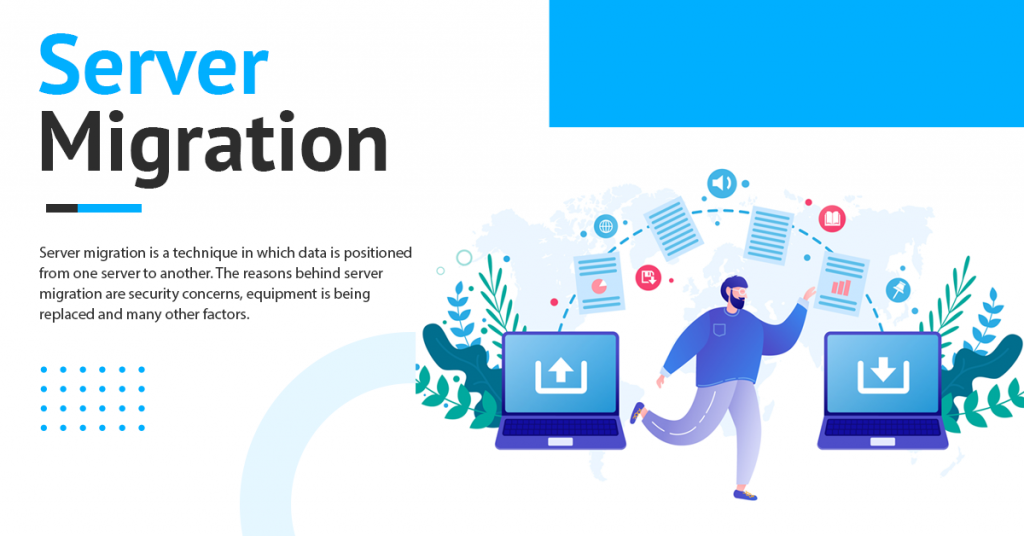What is Server Migration?

Businesses frequently opt for server migration to enhance performance, security, and scalability. Whether the move involves transitioning to another on-premises site, changing service providers, or transitioning to the cloud, the procedure may be intricate but holds significant rewards.
Understanding Server Migration
Server migration refers to moving data, applications, and diverse services from one server to another. It may encompass:
- Transitioning from one physical server to another
- Relocating from an on-premises server to a cloud-based system
- Transferring between distinct cloud environments.
Why Should You Opt for Server Migration?
Server migration is frequently necessary for a variety of reasons:
1. Performance
Over time, your server performance can decline. Transitioning to a new or optimized server can improve website load times, more efficient data processing, and reduce downtime.
2. Cost Efficiency
Older servers often incur higher maintenance and operational costs. Migration provides an opportunity to switch to more cost-effective or energy-efficient hardware.
3. Geographic Relocation
If a business changes its physical location or aims to be closer to its primary user base for improved latency, server migration may be necessary.
4. Merger or Acquisition
Data consolidation onto shared servers may be required during corporate mergers or acquisitions.
5. Transitioning to Cloud Infrastructure
Many businesses are shifting from traditional on-premises to cloud-based servers. It offers better scalability, disaster recovery opportunities, and flexibility.
How to Execute Server Migration?
Server migration can be executed in five simple steps:
Step 1: Prepare the New Server
The initial phase of the server migration process involves getting the new server ready. It encompasses configuring server settings, permissions, and authorizations. Adequate preparation is crucial to prevent losing vital data during the migration.
Several factors should be considered during this phase, such as server size, permissions, performance, and potential scalability in the future.
Taking into account the company’s trajectory is paramount. If there are plans for business expansion, prioritizing scalability and flexibility in handling increased traffic becomes essential for the new server.
It is also vital to ascertain whether the company is adopting any new technologies or services that must be accommodated and integrated into the infrastructure of the new server.
Lastly, effective communication is pivotal. Informing all relevant stakeholders about the scheduled date for the server migration is essential. It includes notifying employees, customers, and shareholders, allowing everyone a designated time frame to accommodate the company’s server migration activities.
Sep 2: Ensuring Data Integrity
Data integrity is a critical process involving meticulously accounting for all data associated with a server migration, ensuring its complete presence and seamless integration into the new server.
Even the loss of a single file, such as a CSS file containing stylistic choices for a website, can have severe consequences for a server, potentially resulting in performance issues with the website.
It’s crucial to assess the quality of files in the old database. Poor quality may give rise to further complications, such as data corruption or challenges in migrating data in the correct format.
Additionally, careful planning is necessary for managing information during this process, aligning with data protection laws, particularly when dealing with sensitive data. Any violation of data protection guidelines can lead to significant fines and harm the reputation of businesses.
Step 3: Data Transfer Process
This procedure phase is the most extensive and time-consuming, involving data movement between servers. Before commencing this stage, it is crucial to confirm the readiness of the new servers and the security of all files.
During the data transfer, information is conveyed via the bandwidth connecting the old and new servers. The efficiency of this process depends on the available bandwidth; the greater the bandwidth, the faster the data transfer, expediting this step.
To prevent miscommunication, informing employees, customers, and shareholders about the transfer date is imperative. Additionally, awareness of concurrent high-traffic events is crucial to avoiding transfer errors, bandwidth issues, and general performance problems during this period.
Step 4: QA Testing
After the data has been successfully transferred from one server to another, subjecting the new server to a comprehensive Quality Assurance (QA) process is recommended. It involves testing the software for potential performance or processing issues.
Allocating a significant portion of time in the migration project for this step is crucial, as it ensures the server is less likely to encounter frequent failures. Since not all data transfers are flawlessly executed, conducting rigorous testing becomes necessary to pinpoint any faults in the software.
The outcomes of this testing phase will serve as valuable insights for a server maintenance team, guiding them on how to troubleshoot and address issues should the server experience downtime. Moreover, it provides a company with best practices for future server migration endeavors.
Documentation of every action taken in this step is imperative. It ensures that individuals working on the server at a later date can refer to this documentation and learn from its findings in case of downtime or other issues.
Step 5: Implement DNS Change for Website Go-Live
The server migration procedure’s concluding step is the website’s DNS transition, redirecting users to the new server.
Though switching a website’s DNS is relatively straightforward, executing it during off-peak hours is advisable to maintain optimal site performance. Off-peak hours typically include nights, weekends, and holidays.
Once the DNS transition is complete, the server is prepared to go live. However, it is crucial to maintain a backup in case any issues arise with the data on the primary server.






